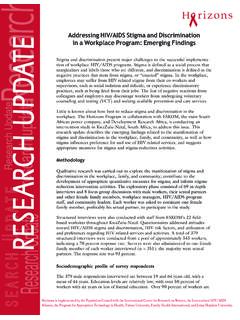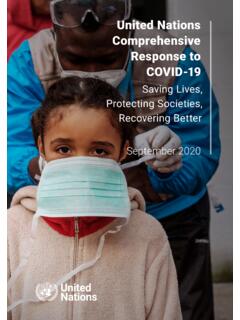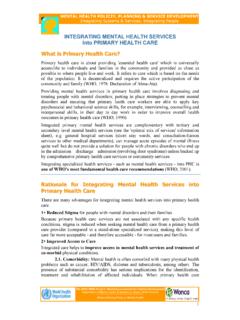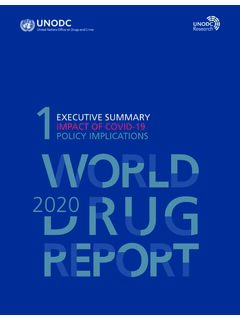Transcription of Tackling HIV Stigma: What works? - National AIDS Trust
1 Tackling hiv stigma : What works? aNATAPRIL 2016 Tackling hiv stigma : What works? Using the global evidence base to reduce the impact of HIV stigmaNAT is the UK s leading charity dedicated to transforming society s response to provide fresh thinking, expert advice and practical campaign for visionOur vision is a world in which people living with HIV are treated as equal citizens with respect, dignity and justice, are diagnosed early and receive the highest standards of care, and in which everyone knows how, and is able, to protect themselves and others from HIV infectionOur strategic goalsAll our work is focused on achieving five strategic goals: xeffective HIV prevention in order to halt the spread of HIV xearly diagnosis of HIV through ethical, accessible and appropriate testing xequitable access to treatment, care and support for people living with HIV xenhanced understanding of the facts about HIV and living with HIV in the UK xeradication of HIV- related stigma and discriminationAlastair Hudson, UK stigma Index 2015 Alison Irving, Waverley CareBoris Cruyssaert, SensoaCatherine Dodds, Sigma Research London School of Hygiene and Tropical MedicineGeorge Valliotis, HIV ScotlandLella Cosmaro, LILAP edro Silverio, Portugese Anti Discrimination Centre HIV/AIDSR ichard Stranz, AIDES Silke Klumb, Deutsche aids -HilfeTeymur Noori, ECDC , report designACKNOWLEDGEMENTSThis paper was produced with the kind support of ViiV Healthcare Positive Action Europe.
2 NAT would like to thank the following people: Tackling hiv stigma : WHAT works? Contents1. Introduction 2 What NAT did 32. stigma : the what, where and how 4 What is stigma made up of? 4 Where do we find stigma ? How do we reduce stigma ? 5 Using the hiv stigma framework to design a strategy for stigma reduction 63. HIV in the United Kingdom 7 Basic facts on the epidemic 7 The legal context 8 Experiences of stigma 8 Public knowledge and attitudes 8 Policy addressing hiv stigma 84. What the evidence tells us about the effectiveness of hiv stigma interventions 10 Mass media campaigns 12 Altering the media narrative Involving people living with HIV 18 Discussing stigma itself 18 Reducing structural inequalities through changes in the law and policy 20 Working in organisations to reduce stigma 22 addressing self- stigma 255. Conclusion: building a combination approach to hiv stigma reduction 28 A summary of what works A summary of recommendations for future policy and practice 311 NATT ackling hiv stigma : What works?
3 INTRODUCTION1 stigma and HIV can sometimes seem to be synonymous; but do they have to be? This paper looks briefly at stigma and stigma theory before examining the evidence of what makes an effective stigma intervention and making a series of recommendations. stigma has a harmful effect on people living with HIV and the HIV epidemic. The impact on the physical and mental well-being of people living with HIV can be significant; experiences of direct discrimination are common and stigma is linked to poorer adherence to treatment and treatment HIV prevention is also dramatically hindered by stigma . Studies have linked stigma to increased risk, non-disclosure and avoidance of health services, including those which may prevent mother to child transmission of stigma is also linked to fear and avoidance of HIV Given the preventive benefits of HIV treatment, the part that stigma plays as a barrier to accessing testing and care has an important role in driving the epidemic. Tackling stigma is vital to improving the lives of people living with HIV and is integral to Tackling HIV.
4 The existence of hiv stigma and its impact is widely recognised but concrete strategies for Tackling it remain elusive. This is for good reason. stigma is a complex social phenomenon. It rests on and reinforces societal power structures and in part develops from the way our minds categorise people and behaviours in order to make sense of the world around us. These are difficult things to change. stigma associated with HIV is particularly complex. Some HIV transmission routes, for example, sex without condoms and sharing of needles for injecting drug use, are subject to social judgement. In some countries behaviours that carry the highest risk of HIV transmission are against the law. In addition, there are a range of intersecting prejudices experienced by many communities disproportionately affected by HIV. For example in the UK, gay and bisexual men and black African communities are disproportionately affected by the virus and issues of racism and homophobia can interlace with hiv stigma .
5 1 Chidrawi. C. H., G. M., & Temane M. Q. (2014) Health behaviour change of people living with HIV after a comprehensive community-based hiv stigma reduction intervention in North-West Province in South Africa. Journal of Social Aspects of HIV/ aids . 11 (1), p222 p2322 Mahajan, A. P., Sayles, J. N., Patel, V. A., Remien, R. H., Ortiz, D., Szekeres, G., Coates, T. J. (2008) stigma in the HIV/ aids epidemic: A review of the literature and recommendations for the way forward. aids . 22 (Suppl 2), p67 p793 ibidTACKLING hiv stigma : WHAT WORKS? Tackling hiv stigma : What works? 2 NATA lthough the complexity of hiv stigma makes it difficult to address, this is not to say nothing has been done to improve resilience of communities affected by HIV and to tackle stigma at its source. Demonstrable successes have been made. A conceptual framework for hiv stigma has been developed. Several studies have looked at the effectiveness of anti- stigma interventions in a variety of settings within the context of this This body of literature is growing and in 2014 UNAIDS drew on this to develop country-level guidance for policy development on reducing What NAT didNAT wanted to gain an overview of what we know about stigma reduction interventions from the academic and non-academic literature, with the aim of finding evidence of effective interventions.
6 In the summer of 2015 NAT issued a call for evidence to the wider HIV sector. This was distributed through NAT s Policy Network of 150 organisations across the UK, and further in Europe through the European Civil Society Forum on HIV. Respondents were asked to provide information on known interventions and available evidence of their effectiveness. This alerted NAT to a number of interventions not otherwise covered in the academic literature. Academic literature was identified through an internet search, recommendations and use of bibliographies from identified sources. NAT also spoke to individuals who had led on anti- stigma campaigns to gain more detailed information on their design, delivery and evidence of success. stigma isn t something that s new and it isn t something that s going to go away overnight. Person living with HIV ( hiv stigma Index UK, 2015)HIV is still intrinsically linked with somehow you having done something wrong, because it s sexually transmitted. I think that we assume that it s our fault that we got it.
7 That s the self-judgement of it. If I didn t have sex, I wouldn t have HIV, fact. Person living with HIV ( hiv stigma Index UK, 2015)4 Stangl, A. L., Lloyd, J. K., Brady, L. M., Holland, C. E., Baral, S. (2013), A systematic review of interventions to reduce HIV-related stigmas and discrimination from 2002-2013: how far have we come? Journal of the International aids Society. 16 (Suppl 2), p1 p145 UNAIDS (2014), Reduction of HIV-related stigma and discrimination . Available at: Tackling hiv stigma : WHAT WORKS? Tackling hiv stigma : What works? 3 NAT2 stigma : THE WHAT, WHERE AND HOWSTIGMA: THE WHAT, WHERE AND HOW2 Early stigma theory defined stigma as a mark of disgrace .7 More recent thinking has developed from this to see stigma as a construct of a range of psychological, social and societal factors, for example, stereotypes, cultural norms, economic circumstances and power stigma holds social structures in place, maintaining boundaries and inequalities between groups of people and between those who have power and those who do What is stigma made up of?
8 Describes a framework for hiv stigma based on the work of a number of agencies and academics working on stigma reduction. It shows stigma as a cycle, where stigma and discrimination reinforce those things that helped to form it in the first place. Drivers These are causes of stigma at an individual level. They are the outcomes of our cognitive processes which help us to make sense of the world around us. Things like fear of transmission from casual contact, lack of awareness and our use of stereotypes all fall into this category. FacilitatorsThese are causes at a societal level that facilitate stigma . They include laws, rights, systems, cultural and gender norms and economic status. Power structuresThese are power structures within society that influence stigma who has power and who does not. Intersecting stigmas These are the multiple prejudices experienced by people at increased risk of HIV within a society. Prejudices associated with same-sex relationships, race, sex work and drug use, for example, all intersect with hiv stigma .
9 6 UNAIDS (2014), Reduction of HIV-related stigma and discrimination . Available at: Goffman E. stigma : notes on the management of spoiled identity . Englewood Hills, NJ: Prentice Hall; Link. B. G., & Phelan. J. C. (2001) Conceptualizing stigma . Annual Review of Sociology. 27, p363 p3859 Parker. R., & Aggleton. P. (2003) HIV and aids -related stigma and discrimination: a conceptual framework and implications for action. Social Science and Medicine. 57, p13 p2410 Dodds, C (2015) Evidence of HIV-related stigma among African people in the UK , presentation at Croydon University Hospital, 3 June 2015. UNAIDS describes hiv stigma as negative beliefs, feelings and attitudes towards people living with HIV and as a process of devaluation of people either living with or associated with HIV and 6 Tackling hiv stigma : What works? 4 NAT2 stigma : THE WHAT, WHERE AND A framework for the construction of hiv stigma , adapted from Stangl et al (2010) and Stangl et al (2012).
10 Manifestations These are how stigma is exhibited or experienced, for example, direct discrimination, thoughts or feelings about a person living with HIV, anticipated stigma or Where do we find stigma ? stigma can be experienced in a range of social environments. This can be thought of as the level or context at which stigma is experienced and it is helpful in determining where we should target stigma reduction They can include: Individual This is how the individual feels about HIV, how they understand and respond to it. Interpersonal and community stigma between individuals, including family, friends, social networks and acquaintances. Organisational stigma within institutions such as the work-place, schools and hospitals. Societal stigma across society as informed by cultural norms and attitudes. Public policyStigma as reflected in National and local laws and policies these will often be related to cultural How do we reduce stigma ? Many different approaches have been used to address stigma .







